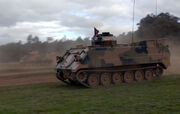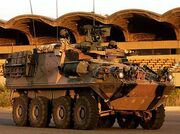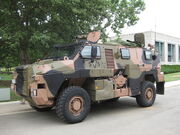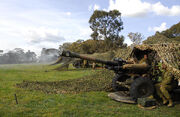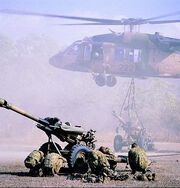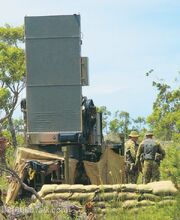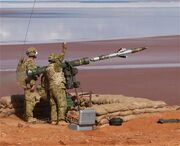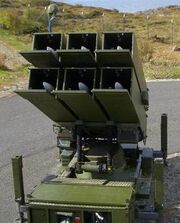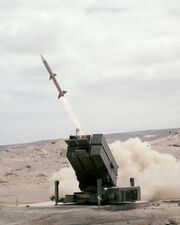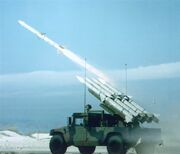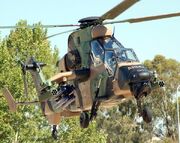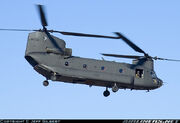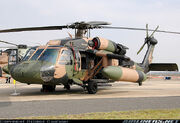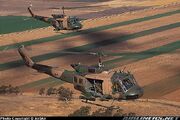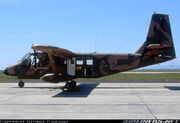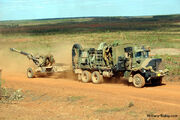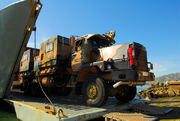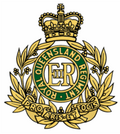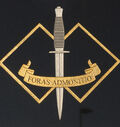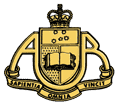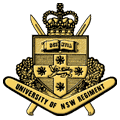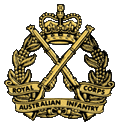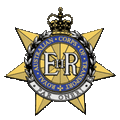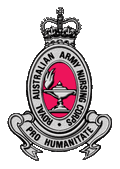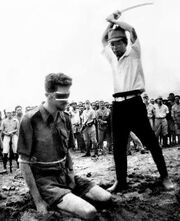| Australian Army | |
| The Australian National Flag | |
| Founded | 1 January 1901 |
| Country | Australia |
| Branch | Army |
| Part of | Australian Defence Force |
| Army Headquarters | Canberra |
| Size | Approximately 45,000 regular personnel |
| Commanders | |
| Chief of the General Staff | Lieutenant General David Morrison, AO |
| Deputy Chief of the General Staff | Major General Paul Symon, AO |
| Land Commander Australia | Major General Jeffrey Sengleman |
| Insignia | |
| Army Badge | 
|
| Combat equipment | |
| Tanks | M1A1 AIM Abrams |
| Reconnaissance vehicles | ASLAV |
| APCs | ASLAV-PC, M113AS3, M113AS4, M113A1, Bushmaster |
| Artillery | M198, L119, HIMARS, M2A2 |
| Air Defence | FIM-92, RBS-70, SL-AMRAAM |
| Small Arms | |
| Rifle | F88 Austeyr |
| Machine guns | F89 Minimi, MAG 58, M2 QCHB HMG |
| Pistols | L9A1 Browning |
| Aircraft flown | |
| Attack Helicopter | Tiger ARH |
| Transport Helicopter | S-70A-9 Black Hawk, S-70A-44 Black Hawk, CH-47D Chinook |
| Reconnaissance | CA-32 Kiowa, PC-6 Turbo Porter |
| Utility | UH-1H Iroquois |
The Australian Army is Australia's military land force. It is part of the Australian Defence Force (ADF) along with the Royal Australian Navy and the Royal Australian Air Force. The Army is commanded by the Chief of the General Staff (CGS), who is responsible to the Chief of the Defence Force Staff (CDS). The current Chief of the General Staff is Lieutenant General David Morrison, AO.
Australian soldiers have been involved in a number of minor and major conflicts throughout its history, but only in World War II did Australian territory come under direct attack.
Mission[]
Australian Government websites state that the Army's mission is to provide a potent, versatile and modern Army to promote the security of Australia and protect its people and interests. Further, the Army's key doctrine publication, The Fundamentals of Land Warfare, states that "the Army's mission is to win the land battle".
Organsation[]
Regular Forces[]
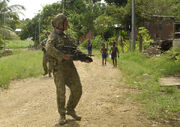
Australian soldiers on patrol
The Regular element of the Australian Army is called the Australian Regular Army. The Australian Army consists of a number of Brigades, each of which has different roles. The Brigades are based around infantry battalions. To the infantry battalions are added armour, cavalry, artillery, aviation, engineers, signals, and combat support elements make up complete land forces suited to any operations in support of Australian national objectives. Aviation is held in a single brigade and deployed as required to other brigades for training and operational missions.
- 1 Brigade (Mechanised Brigade)
- 1st Armoured Regiment (Armoured Regiment, M1A1 Abrams)
- 2nd Cavalry Regiment (Formation Reconnaissance Regiment, ASLAV)
- 5th Battalion, Royal Australian Regiment
- 7th Battalion, Royal Australian Regiment
- 8th/12th Medium Regiment, Royal Australian Artillery
- 5th Air Defence (Mechanised) Regiment, Royal Australian Artillery
- 1st Combat Engineer Regiment
- 1st Combat Signal Regiment
- 1st Combat Support Regiment
- 2 Brigade (Motorised Brigade, equipped with Bushmaster IMV)
- 2nd/14th Light Horse Regiment (Formation Reconnaissance Regiment, ASLAV)
- 1st Battalion, Royal Australian Regiment
- 4th Battalion, Royal Australian Regiment
- 6th Battalion, Royal Australian Regiment
- 1st Field Regiment, Royal Australian Artillery
- 11th Air Defence Regiment, Royal Australian Artillery
- 2nd Combat Engineer Regiment
- 2nd Combat Signal Regiment
- 4th Combat Service Support Battalion
- 3 Brigade (Motorised Brigade, equipped with Bushmaster IMV)
- 3rd/4th Cavalry Regiment (Formation Reconnaissance Regiment, ASLAV)
- 2nd Battalion, Royal Australian Regiment
- 9th Battalion, Royal Australian Regiment
- 10th Battalion, Royal Australian Regiment
- 14th Field Regiment, Royal Australian Artillery
- 9th Air Defence Regiment, Royal Australian Artillery
- 3rd Combat Engineer Regiment
- 3rd Combat Signal Regiment
- 5th Combat Service Support Battalion
- 4 Brigade (Light Infantry Brigade)
- V Squadron, 3rd/4th Cavalry Regiment, Armoured Personnel Carrier Squadron (Bushmaster IMV)
- 3rd Battalion, Royal Australian Regiment (Airborne)
- 8th Battalion, Royal Australian Regiment
- 4th Field Regiment, Royal Australian Artillery
- 16th Air Defence Regiment, Royal Australian Artillery
- 4th Combat Engineer Regiment
- 4th Combat Signal Regiment
- 6th Combat Service Support Battalion
- 5 (NZ) Brigade (Motorised Brigade, equipped with Bushmaster IMV)
- Queen Alexandra's Mounted Rifles, Formation Reconnaissance Regiment (ASLAV)
- 1st Battalion, Royal New Zealand Infantry Regiment
- 3rd Battalion, Royal New Zealand Infantry Regiment
- 16th Field Regiment, Royal New Zealand Artillery
- 5th Air Defence Regiment, Royal New Zealand Artillery
- 5th Combat Engineer Regiment
- 5th Combat Signal Regiment
- 7th Combat Service Support Battalion
- 14 Brigade (Combat Support and Intelligence, Surveillance, Target Acquisition and Reconnaissance)
- 6 Engineer Support Regiment
- 1st Ground Liaison Group
- 1st Intelligence Battalion
- 2/30th Training Group
- 7th Signal Regiment
- 19th Chief Engineer Works
- 20th Surveillance and Target Acquisition Regiment, Royal Australian Artillery
- 51st Battalion, Far North Queensland Regiment
- NORFORCE
- Pilbara Regiment
- 15 Combat Service Support Brigade
- 2nd Force Support Battalion
- 9th Force Support Battalion
- 10th Force Support Battalion
- 1st Health Support Battalion
- 2nd Health Support Battalion
- 3rd Health Support Battalion
- 1st Psychology Unit
- 39th (Personnel Support) Battalion
- 17th Signals Regiment
- 16 (Aviation) Brigade
- 1st Aviation Regiment (attack helicopter regiment, 3 Tiger ARH SQN)
- 2nd Aviation Regiment (medium transport helicopter regiment, 1 CH-47D SQN, 3 S-70A-9 SQN)
- 4th Aviation Regiment (training regiment)
- Australian Defence Force Helicopter School (AS.350B)
- School of Army Aviation (CA-32, Turbo Porter, UH-1H)
- 5th Aviation Regiment (assault transport helicopter regiment, 1 S-70A-9 SQN, 2 S-70A-44 SQN)
- 6th Aviation Regiment (light aircraft regiment, 1 Beech King Air SQN, 1 Nomad SQN, 3 Turbo Porter SQN)
- 7th Aviation Regiment (transport helicopter regiment, 3 UH-1H SQN)
- 8th Aviation Regiment (reconnaissance helicopter regiment, 3 CA-32 SQN)
Special Forces[]
Special Forces are controlled by Australian Special Operations Command. The special forces units of the Australian Army consist of units of special operators (either Commando or SAS), and support units from other corps.
- Australian Special Air Service Regiment
- Special Air Service of New Zealand
- 2nd Commando Regiment (regular)
- 1st Commando Regiment (reserve)
- Incident Response Regiment
- Special response unit for nuclear, biological, chemical and radiological hazards, and explosive hazards.
- 152 Signal Squadron
- 126 Commando Signal Squadron
- 301 Signal Squadron (Reserve)
- Special Operations Logistics Squadron
- Special Forces Training Centre
Regional Force Surveillance Units[]
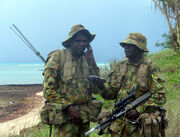
Aboriginal soldiers from NORFORCE on operations
The Regional Force Surveillance Units (RFSUs) are specialised units of the Australian Army responsible for patrolling northern Australia. The RFSUs regularly conduct operational patrols during peacetime, and the reservists who make up 90% of the RFSUs personnel carry out most of their training during these patrols.
- North-West Mobile Force (NORFORCE) (responsible for the Northern Territory and Kimberley region of Western Australia)
- The Pilbara Regiment (responsible for the Pilbara region of Western Australia)
- 51st Battalion, Far North Queensland Regiment (responsible for North Queensland)
Army Reserve[]
Army Reserve which is sometimes abbreviated to ARes is a collective name for the reserve units of the Australian Army. Australian Reservists have a comparatively high level of commitment, with an expected obligation of up to 4 nights and 2 full days per month, alongside a two week annual course. Since September of 2006, reservist salaries have been streamlined with those of regular forces as a reflection of overall higher standard of training. This initiative shows that in recent decades, there are now many positions for which there is little training gap at all between Reservists and Permanent Force members.
Reserve Brigades[]
- 6 (Victoria) Brigade
- 5th/6th Battalion, Royal Victoria Regiment
- 8th/7th Battalion, Royal Victoria Regiment
- 4th/19th Prince of Wales's Light Horse
- 2/10th Medium Regiment, Royal Australian Artillery
- 19th Air Defence Regiment, Royal Australian Artillery
- Melbourne University Regiment
- Monash University Regiment
- 108th Signals Squadron
- 6th Combat Engineer Regiment, Royal Australian Engineers
- 6th Combat Service Support Battalion
- 22nd Construction Regiment, Royal Australian Engineers
- 7 (New South Wales) Brigade
- 1st/19th Battalion, Royal New South Wales Regiment
- 2nd/17th Battalion, Royal New South Wales Regiment
- 1st/15th Royal New South Wales Lancers
- 23rd Field Regiment, Royal Australian Artillery
- 24th Air Defence Regiment, Royal Australian Artillery
- Sydney University Regiment
- University of New South Wales Regiment
- 7th Combat Engineer Regiment
- 21st Construction Regiment (located at Holsworthy Barracks)
- 142nd Signals Squadron
- 7th Combat Service Support Battalion
- 8 (Northern New South Wales) Brigade
- 4th/3rd Battalion, Royal New South Wales Regiment
- 41st Battalion, Royal New South Wales Regiment
- 12th/16th Hunter River Lancers
- 7th Field Regiment, Royal Australian Artillery
- 8th Combat Engineer Regiment
- 155th Signals Squadron
- 8th Combat Service Support Battalion
- 9 (SA, Tasmana) Brigade
- 10th/27th Battalion, Royal South Australia Regiment
- 12th/40th Battalion, Royal Tasmania Regiment
- 3rd/9th South Australia Mounted Rifles
- 3rd Field Regiment, Royal Australian Artillery
- Adelaide Universities Regiment
- 3rd Field Squadron, Royal Australian Engineers
- 144th Signals Squadron
- 9th Combat Service Support Battalion
- 10 (Queensland) Brigade
- 9th Battalion, Royal Queensland Regiment
- 25th/49th Battalion, Royal Queensland Regiment
- 31st/42nd Battalion, Royal Queensland Regiment
- 6/13th Field Regiment, Royal Australian Artillery
- Queensland University Regiment
- 11th Combat Services Support Battalion
- 141st Signals Squadron
- 35th Field Squadron, Royal Australian Engineers
- 11 (WA) Brigade
- 11th/28th Battalion, Royal Western Australia Regiment
- 16th Battalion, Royal Western Australia Regiment
- 10th Light Horse
- Western Australia University Regiment
- 11st Combat Services Support Battalion
- 109th Signals Squadron
- 13th Field Squadron, Royal Australian Engineers
- 12 (Pacific) Brigade
- 2nd Battalion, Royal New Zealand Infantry Regiment
- 4th Battalion, Royal New Zealand Infantry Regiment
- 1st Battalion, Royal Pacific Islands Regiment
- 2nd Battalion, Royal Pacific Islands Regiment
- Waikato Mounted Rifles
- Auckland University Regiment
- Massey University Regiment
- Papua New Guinea University Regiment
- 11th Composite Regiment, Royal New Zealand Artillery
- 18th Field Squadron, Royal Australian Engineers
- 12th Combat Services Support Battalion
- 114th Signals Squadron
Corps[]
Corps act as parents for the various regiments, and battalions in the Australian Army, as well as the 'home' for personnel. For example, an M88A2 Armoured Recovery Vehicle will form part of an armoured unit under the Royal Australian Armoured Corps, but the crew will be drawn from the Royal Australian Electrical and Mechanical Engineers.
Corps are also responsible for training and developing doctrine for relevant units, the Royal Australian Infantrry Corp for example runs Infantry Training Courses.
- Royal Australian Armoured Corps
- Royal Regiment of Australian Artillery
- Australian Army Aviation
- Royal Australian Engineers
- Royal Australian Corps of Signals
- Royal Australian Infantry Corps
- Australian Army Band Corps
- Australian Army Intelligence Corps
- Royal Australian Corps of Transport
- Australian Army Catering Corps
- Royal Australian Army Medical Corps
- Australian Army Psychology Corps
- Royal Australian Army Nursing Corps
- Royal Australian Army Dental Corps
- Royal Australian Army Ordnance Corps
- Royal Australian Electrical and Mechanical Engineers
- Royal Australian Corps of Military Police
- Royal Australian Army Pay Corps
- Australian Army Legal Corps
- Royal Australian Army Education Corps
- Royal Australian Chaplains Department
- Royal Australian Survey Corps
- Australian Army Public Relations Service
- Corps of Staff Cadets
Equipment[]
Small Arms[]
Pistols[]
- http://upload.wikimedia.org/wikipedia/commons/thumb/9/92/Flag_of_Belgium_(civil).svg/22px-Flag_of_Belgium_(civil).svg.png L9A1 Browning Hi-Power Pistol
- http://upload.wikimedia.org/wikipedia/commons/thumb/b/ba/Flag_of_Germany.svg/22px-Flag_of_Germany.svg.png Heckler und Koch USP Pistol (Special Forces)
Rifles[]
- http://upload.wikimedia.org/wikipedia/commons/thumb/4/41/Flag_of_Austria.svg/22px-Flag_of_Austria.svg.png /
 F88 Austeyr Rifle
F88 Austeyr Rifle
- http://upload.wikimedia.org/wikipedia/commons/thumb/4/41/Flag_of_Austria.svg/22px-Flag_of_Austria.svg.png /
 F88C Carbine
F88C Carbine - http://upload.wikimedia.org/wikipedia/commons/thumb/4/41/Flag_of_Austria.svg/22px-Flag_of_Austria.svg.png /
 F88S Austeyr Rifle
F88S Austeyr Rifle - http://upload.wikimedia.org/wikipedia/commons/thumb/4/41/Flag_of_Austria.svg/22px-Flag_of_Austria.svg.png /
 F88S-A1C Carbine
F88S-A1C Carbine - http://upload.wikimedia.org/wikipedia/commons/thumb/4/41/Flag_of_Austria.svg/22px-Flag_of_Austria.svg.png /
 F88 GLA Rifle/Grenade Launcher Attachment
F88 GLA Rifle/Grenade Launcher Attachment - http://upload.wikimedia.org/wikipedia/commons/thumb/4/41/Flag_of_Austria.svg/22px-Flag_of_Austria.svg.png /
 F88T .22 Training Rifle
F88T .22 Training Rifle
- http://upload.wikimedia.org/wikipedia/commons/thumb/4/41/Flag_of_Austria.svg/22px-Flag_of_Austria.svg.png /
- http://upload.wikimedia.org/wikipedia/commons/thumb/a/a4/Flag_of_the_United_States.svg/22px-Flag_of_the_United_States.svg.png M4A5 Carbine (Special Forces)
- http://upload.wikimedia.org/wikipedia/commons/thumb/a/a4/Flag_of_the_United_States.svg/22px-Flag_of_the_United_States.svg.png SR-25 Carbine (Special Forces)
- http://upload.wikimedia.org/wikipedia/commons/thumb/9/92/Flag_of_Belgium_(civil).svg/22px-Flag_of_Belgium_(civil).svg.png /
 L1A1 SLR (Ceremonial)
L1A1 SLR (Ceremonial)
Submachine Guns[]
- http://upload.wikimedia.org/wikipedia/commons/thumb/b/ba/Flag_of_Germany.svg/22px-Flag_of_Germany.svg.png Heckler und Koch MP5 Submachine Gun (Special Forces)
Machine guns[]
- http://upload.wikimedia.org/wikipedia/commons/thumb/9/92/Flag_of_Belgium_(civil).svg/22px-Flag_of_Belgium_(civil).svg.png /
 F89 Minimi Light Machine Gun
F89 Minimi Light Machine Gun
- http://upload.wikimedia.org/wikipedia/commons/thumb/a/ae/Flag_of_the_United_Kingdom.svg/22px-Flag_of_the_United_Kingdom.svg.png /
 L4A1 BREN 7.62mm Light Machine Gun
L4A1 BREN 7.62mm Light Machine Gun - http://upload.wikimedia.org/wikipedia/commons/thumb/9/92/Flag_of_Belgium_(civil).svg/22px-Flag_of_Belgium_(civil).svg.png MAG 58 General Purpose Machine Gun
- http://upload.wikimedia.org/wikipedia/commons/thumb/a/a4/Flag_of_the_United_States.svg/22px-Flag_of_the_United_States.svg.png / http://upload.wikimedia.org/wikipedia/commons/thumb/9/92/Flag_of_Belgium_(civil).svg/22px-Flag_of_Belgium_(civil).svg.png M2HB-QCB Heavy Machine Gun
Sniper Rifles[]
- http://upload.wikimedia.org/wikipedia/commons/thumb/a/ae/Flag_of_the_United_Kingdom.svg/22px-Flag_of_the_United_Kingdom.svg.png SR-98 Sniper Rifle
- http://upload.wikimedia.org/wikipedia/commons/thumb/a/a4/Flag_of_the_United_States.svg/22px-Flag_of_the_United_States.svg.png SR-25 Sniper Rifle (Special Forces)
- http://upload.wikimedia.org/wikipedia/commons/thumb/a/ae/Flag_of_the_United_Kingdom.svg/22px-Flag_of_the_United_Kingdom.svg.png AW50F Anti-Material Rifle
Support Weapons[]
 F1 Fragmentation Hand Grenade
F1 Fragmentation Hand Grenade- http://upload.wikimedia.org/wikipedia/commons/thumb/a/a4/Flag_of_the_United_States.svg/22px-Flag_of_the_United_States.svg.png M18 Claymore mine
- http://upload.wikimedia.org/wikipedia/commons/thumb/a/a4/Flag_of_the_United_States.svg/22px-Flag_of_the_United_States.svg.png Remington 870 Shotgun
- http://upload.wikimedia.org/wikipedia/commons/thumb/a/a4/Flag_of_the_United_States.svg/22px-Flag_of_the_United_States.svg.png M203-PI Grenade Launcher
- http://upload.wikimedia.org/wikipedia/commons/thumb/a/a4/Flag_of_the_United_States.svg/22px-Flag_of_the_United_States.svg.png Mk 19 Automatic Grenade Launcher
- http://upload.wikimedia.org/wikipedia/commons/thumb/a/a4/Flag_of_the_United_States.svg/22px-Flag_of_the_United_States.svg.png 66 mm Short-Range Anti-Armour Weapon
- http://upload.wikimedia.org/wikipedia/commons/thumb/4/4c/Flag_of_Sweden.svg/22px-Flag_of_Sweden.svg.png 84mm M2 Carl Gustav Medium Range Anti-Armour Weapon (MRAAW)
- http://upload.wikimedia.org/wikipedia/commons/thumb/4/4c/Flag_of_Sweden.svg/22px-Flag_of_Sweden.svg.png 84mm M3 Carl Gustav Medium Range Anti-Armour Weapon (MRAAW)
- http://upload.wikimedia.org/wikipedia/commons/thumb/a/a4/Flag_of_the_United_States.svg/22px-Flag_of_the_United_States.svg.png FGM-148 Javelin
- http://upload.wikimedia.org/wikipedia/commons/thumb/c/c3/Flag_of_France.svg/22px-Flag_of_France.svg.png / http://upload.wikimedia.org/wikipedia/commons/thumb/b/ba/Flag_of_Germany.svg/22px-Flag_of_Germany.svg.png Milan Anti Tank Missile (Being replaced with Javelin)
Armoured Vehicles[]
- http://upload.wikimedia.org/wikipedia/commons/thumb/a/a4/Flag_of_the_United_States.svg/22px-Flag_of_the_United_States.svg.png M1A1 AIM Abrams Main Battle Tank
- http://upload.wikimedia.org/wikipedia/commons/thumb/a/a4/Flag_of_the_United_States.svg/22px-Flag_of_the_United_States.svg.png M104 Wolverine Heavy Assault Bridge
- http://upload.wikimedia.org/wikipedia/commons/thumb/a/a4/Flag_of_the_United_States.svg/22px-Flag_of_the_United_States.svg.png M88A2 Hercules Armoured Recovery Vehicle
- http://upload.wikimedia.org/wikipedia/commons/thumb/a/a4/Flag_of_the_United_States.svg/22px-Flag_of_the_United_States.svg.png /
 M113AS3 Armoured Personnel Carrier
M113AS3 Armoured Personnel Carrier
- http://upload.wikimedia.org/wikipedia/commons/thumb/a/a4/Flag_of_the_United_States.svg/22px-Flag_of_the_United_States.svg.png /
 M113AS4 Stretched Armoured Personnel Carrier
M113AS4 Stretched Armoured Personnel Carrier - http://upload.wikimedia.org/wikipedia/commons/thumb/a/a4/Flag_of_the_United_States.svg/22px-Flag_of_the_United_States.svg.png /
 M901AS3 AT Improved TOW Vehicle
M901AS3 AT Improved TOW Vehicle - http://upload.wikimedia.org/wikipedia/commons/thumb/a/a4/Flag_of_the_United_States.svg/22px-Flag_of_the_United_States.svg.png /
 M577AS3 ACV Armoured Command Vehicle
M577AS3 ACV Armoured Command Vehicle - http://upload.wikimedia.org/wikipedia/commons/thumb/a/a4/Flag_of_the_United_States.svg/22px-Flag_of_the_United_States.svg.png /
 M125AS3 AM Armoured Mortar (F2 81mm Mortar Carrier)
M125AS3 AM Armoured Mortar (F2 81mm Mortar Carrier) - http://upload.wikimedia.org/wikipedia/commons/thumb/a/a4/Flag_of_the_United_States.svg/22px-Flag_of_the_United_States.svg.png /
 M579AS4 F Fitter's Vehicle
M579AS4 F Fitter's Vehicle - http://upload.wikimedia.org/wikipedia/commons/thumb/a/a4/Flag_of_the_United_States.svg/22px-Flag_of_the_United_States.svg.png /
 M806AS4 ARVL Armoured Recovery Vehicle Light
M806AS4 ARVL Armoured Recovery Vehicle Light - http://upload.wikimedia.org/wikipedia/commons/thumb/a/a4/Flag_of_the_United_States.svg/22px-Flag_of_the_United_States.svg.png /
 M113AS4 AA Armoured Ambulance
M113AS4 AA Armoured Ambulance - http://upload.wikimedia.org/wikipedia/commons/thumb/a/a4/Flag_of_the_United_States.svg/22px-Flag_of_the_United_States.svg.png /
 M113AS4 ALV Armoured Logistics Vehicle
M113AS4 ALV Armoured Logistics Vehicle
- http://upload.wikimedia.org/wikipedia/commons/thumb/a/a4/Flag_of_the_United_States.svg/22px-Flag_of_the_United_States.svg.png /
- http://upload.wikimedia.org/wikipedia/commons/thumb/c/cf/Flag_of_Canada.svg/22px-Flag_of_Canada.svg.png ASLAV
- http://upload.wikimedia.org/wikipedia/commons/thumb/c/cf/Flag_of_Canada.svg/22px-Flag_of_Canada.svg.png ASLAV-25 (Reconnaissance)
- http://upload.wikimedia.org/wikipedia/commons/thumb/c/cf/Flag_of_Canada.svg/22px-Flag_of_Canada.svg.png ASLAV-AT (Anti-Tank)
- http://upload.wikimedia.org/wikipedia/commons/thumb/c/cf/Flag_of_Canada.svg/22px-Flag_of_Canada.svg.png ASLAV-AD (Air Defence)
- http://upload.wikimedia.org/wikipedia/commons/thumb/c/cf/Flag_of_Canada.svg/22px-Flag_of_Canada.svg.png ASLAV-M (F2 81mm Mortar Carrier)
- http://upload.wikimedia.org/wikipedia/commons/thumb/c/cf/Flag_of_Canada.svg/22px-Flag_of_Canada.svg.png ASLAV-PC (Personnel Carrier)
- http://upload.wikimedia.org/wikipedia/commons/thumb/c/cf/Flag_of_Canada.svg/22px-Flag_of_Canada.svg.png ASLAV-S (Surveillance)
- http://upload.wikimedia.org/wikipedia/commons/thumb/c/cf/Flag_of_Canada.svg/22px-Flag_of_Canada.svg.png ASLAV-A (Ambulance)
- http://upload.wikimedia.org/wikipedia/commons/thumb/c/cf/Flag_of_Canada.svg/22px-Flag_of_Canada.svg.png ASLAV-C (Command)
- http://upload.wikimedia.org/wikipedia/commons/thumb/c/cf/Flag_of_Canada.svg/22px-Flag_of_Canada.svg.png ASLAV-CS (Combat Support)
- http://upload.wikimedia.org/wikipedia/commons/thumb/c/cf/Flag_of_Canada.svg/22px-Flag_of_Canada.svg.png ASLAV-F (Fitter)
- http://upload.wikimedia.org/wikipedia/commons/thumb/c/cf/Flag_of_Canada.svg/22px-Flag_of_Canada.svg.png ASLAV-R (Recovery)
 Bushmaster
Bushmaster
Reserve Equipment[]
Reservists use normal Army vehicles with the following exceptions:
- http://upload.wikimedia.org/wikipedia/commons/thumb/a/a4/Flag_of_the_United_States.svg/22px-Flag_of_the_United_States.svg.png M113A1 Armoured Personnel Carrier
- http://upload.wikimedia.org/wikipedia/commons/thumb/a/a4/Flag_of_the_United_States.svg/22px-Flag_of_the_United_States.svg.png M113A1 Light Reconnaissance Vehicle (standard M113A1 with Cadillac Gage T50 turret, most common variant, used as an APC)
- http://upload.wikimedia.org/wikipedia/commons/thumb/a/a4/Flag_of_the_United_States.svg/22px-Flag_of_the_United_States.svg.png / http://upload.wikimedia.org/wikipedia/commons/thumb/a/ae/Flag_of_the_United_Kingdom.svg/22px-Flag_of_the_United_Kingdom.svg.png M113A1 Medium Reconnaissance Vehicle (M113A1 with Scorpion Turret)
- http://upload.wikimedia.org/wikipedia/commons/thumb/a/a4/Flag_of_the_United_States.svg/22px-Flag_of_the_United_States.svg.png M901A1 Improved TOW Vehicle
- http://upload.wikimedia.org/wikipedia/commons/thumb/a/a4/Flag_of_the_United_States.svg/22px-Flag_of_the_United_States.svg.png M125A1 81mm Mortar Carrier
- http://upload.wikimedia.org/wikipedia/commons/thumb/a/a4/Flag_of_the_United_States.svg/22px-Flag_of_the_United_States.svg.png M577A1 Command Vehicle
- http://upload.wikimedia.org/wikipedia/commons/thumb/a/a4/Flag_of_the_United_States.svg/22px-Flag_of_the_United_States.svg.png M548A1 "Tilly" (Tracked Load Carrier)
- http://upload.wikimedia.org/wikipedia/commons/thumb/a/a4/Flag_of_the_United_States.svg/22px-Flag_of_the_United_States.svg.png M579 Fitters Vehicle
- http://upload.wikimedia.org/wikipedia/commons/thumb/a/a4/Flag_of_the_United_States.svg/22px-Flag_of_the_United_States.svg.png M806 Recovery Vehicle
Artillery[]
- http://upload.wikimedia.org/wikipedia/commons/thumb/a/ae/Flag_of_the_United_Kingdom.svg/22px-Flag_of_the_United_Kingdom.svg.png /
 F2 81mm Mortar
F2 81mm Mortar - http://upload.wikimedia.org/wikipedia/commons/thumb/a/a4/Flag_of_the_United_States.svg/22px-Flag_of_the_United_States.svg.png M40 106mm direct fire support recoilless rifle
- http://upload.wikimedia.org/wikipedia/commons/thumb/a/ae/Flag_of_the_United_Kingdom.svg/22px-Flag_of_the_United_Kingdom.svg.png /
 L119 Hamel 105mm Light Gun
L119 Hamel 105mm Light Gun - http://upload.wikimedia.org/wikipedia/commons/thumb/a/a4/Flag_of_the_United_States.svg/22px-Flag_of_the_United_States.svg.png M2A2 105mm howitzer (Reserve)
- http://upload.wikimedia.org/wikipedia/commons/thumb/a/a4/Flag_of_the_United_States.svg/22px-Flag_of_the_United_States.svg.png M198 155mm howitzer
- http://upload.wikimedia.org/wikipedia/commons/thumb/a/a4/Flag_of_the_United_States.svg/22px-Flag_of_the_United_States.svg.png AN/TPQ-36 Firefinder weapon locating radar
Surface to Air Missiles[]
- http://upload.wikimedia.org/wikipedia/commons/thumb/a/a4/Flag_of_the_United_States.svg/22px-Flag_of_the_United_States.svg.png FIM-92 Stinger (ASLAV-AD)
- http://upload.wikimedia.org/wikipedia/commons/thumb/4/4c/Flag_of_Sweden.svg/22px-Flag_of_Sweden.svg.png RBS-70
- http://upload.wikimedia.org/wikipedia/commons/thumb/a/a4/Flag_of_the_United_States.svg/22px-Flag_of_the_United_States.svg.png AIM-120 AMRAAM
- http://upload.wikimedia.org/wikipedia/commons/thumb/a/a4/Flag_of_the_United_States.svg/22px-Flag_of_the_United_States.svg.png / http://upload.wikimedia.org/wikipedia/commons/thumb/d/d9/Flag_of_Norway.svg/22px-Flag_of_Norway.svg.png NASAMS (Norwegian Advanced SAM System)
- http://upload.wikimedia.org/wikipedia/commons/thumb/a/a4/Flag_of_the_United_States.svg/22px-Flag_of_the_United_States.svg.png /
 HUMRAAM (HMMWV Launched AMRAAM, Australian version has 5 missiles on a Right Hand Drive HMMWV made in Australia by GM Holden under license from AM General, used to provide medium range air defence to Airborne units)
HUMRAAM (HMMWV Launched AMRAAM, Australian version has 5 missiles on a Right Hand Drive HMMWV made in Australia by GM Holden under license from AM General, used to provide medium range air defence to Airborne units)
Aircraft[]
- http://upload.wikimedia.org/wikipedia/commons/thumb/b/b7/Flag_of_Europe.svg/22px-Flag_of_Europe.svg.png /
 Eurocopter Tiger ARH
Eurocopter Tiger ARH - http://upload.wikimedia.org/wikipedia/commons/thumb/a/a4/Flag_of_the_United_States.svg/22px-Flag_of_the_United_States.svg.png Boeing CH-47D Chinook
- http://upload.wikimedia.org/wikipedia/commons/thumb/a/a4/Flag_of_the_United_States.svg/22px-Flag_of_the_United_States.svg.png Boeing CH-47F Chinook
- http://upload.wikimedia.org/wikipedia/commons/thumb/a/a4/Flag_of_the_United_States.svg/22px-Flag_of_the_United_States.svg.png /
 HdH/Sikorsky S-70A-9 Black Hawk
HdH/Sikorsky S-70A-9 Black Hawk - http://upload.wikimedia.org/wikipedia/commons/thumb/a/a4/Flag_of_the_United_States.svg/22px-Flag_of_the_United_States.svg.png /
 HdH/Sikorsky S-70A-44 Black Hawk
HdH/Sikorsky S-70A-44 Black Hawk - http://upload.wikimedia.org/wikipedia/commons/thumb/a/a4/Flag_of_the_United_States.svg/22px-Flag_of_the_United_States.svg.png Bell UH-1H Iroquois
- http://upload.wikimedia.org/wikipedia/commons/thumb/a/a4/Flag_of_the_United_States.svg/22px-Flag_of_the_United_States.svg.png /
 CAC CA-32 Kiowa
CAC CA-32 Kiowa - http://upload.wikimedia.org/wikipedia/commons/thumb/f/f3/Flag_of_Switzerland.svg/20px-Flag_of_Switzerland.svg.png Pilatus PC-6 Turbo Porter
 Gippsland Aeronautics Nomad
Gippsland Aeronautics Nomad- http://upload.wikimedia.org/wikipedia/commons/thumb/a/a4/Flag_of_the_United_States.svg/22px-Flag_of_the_United_States.svg.png Beech King Air 350
- http://upload.wikimedia.org/wikipedia/commons/thumb/c/c3/Flag_of_France.svg/22px-Flag_of_France.svg.png Eurocopter AS 350BA Squirrel
Support Vehicles and Watercraft[]
- http://upload.wikimedia.org/wikipedia/commons/thumb/9/9e/Flag_of_Japan.svg/22px-Flag_of_Japan.svg.png Yamaha XT 600 motorcycle
 Land Rover Perentie
Land Rover Perentie
- 4x4 variants
- Truck, Utility
- Truck, Panel, Survey
- Truck, Carryall, Senior Commander
- Truck, Carryall, Personnel Carrier
- 6x6 variants
- Truck, Cargo
- Truck, Ambulance
- Truck, General Maintenance
- Truck, Electronic Repair
- Truck, Long Range Patrol
- Truck, Air Defence
- Truck, Crew Cab
- 4x4 variants
- http://upload.wikimedia.org/wikipedia/commons/thumb/b/ba/Flag_of_Germany.svg/22px-Flag_of_Germany.svg.png Mercedes-Benz Unimog U1700L 4x4 4-tonne truck
- Truck with shelter
- Medium Recovery Vehicles (MRV)
- Truck, Long Range Patrol
 Mack RM6866RS 6x6 8-tonne Truck
Mack RM6866RS 6x6 8-tonne Truck
- Truck, cargo, heavy
- Truck, wrecker
- Heavy Recovery Vehicle
- Truck, cargo, army tractor/Medium gun
- Truck, tank, fuel
- Truck, tank, water
- Truck, dump, heavy
- Truck, bridge recovery, heavy
- Mixer, concrete, truck-mounted
- Distributor, bituminous substance, tank type, truck-mounted
 Mack Fleetliner
Mack Fleetliner International SF2670 Heavy Equipment Transporter
International SF2670 Heavy Equipment Transporter MAN TGA Heavy Equipment Transporter
MAN TGA Heavy Equipment Transporter- http://upload.wikimedia.org/wikipedia/commons/thumb/a/a4/Flag_of_the_United_States.svg/22px-Flag_of_the_United_States.svg.png LARC V
- http://upload.wikimedia.org/wikipedia/commons/thumb/a/a4/Flag_of_the_United_States.svg/22px-Flag_of_the_United_States.svg.png LCM-8 (Landing Craft Mechanised)
Aerial Weapons[]
- http://upload.wikimedia.org/wikipedia/commons/thumb/c/c3/Flag_of_France.svg/22px-Flag_of_France.svg.png GIAT 30 30mm cannon
- http://upload.wikimedia.org/wikipedia/commons/thumb/a/a4/Flag_of_the_United_States.svg/22px-Flag_of_the_United_States.svg.png M134D 7.62mm Minigun
- http://upload.wikimedia.org/wikipedia/commons/thumb/9/92/Flag_of_Belgium_(civil).svg/22px-Flag_of_Belgium_(civil).svg.png MAG 58 7.62mm GPMG
- http://upload.wikimedia.org/wikipedia/commons/thumb/a/a4/Flag_of_the_United_States.svg/22px-Flag_of_the_United_States.svg.png AGM-114 Hellfire
- http://upload.wikimedia.org/wikipedia/commons/thumb/a/a4/Flag_of_the_United_States.svg/22px-Flag_of_the_United_States.svg.png 70mm Hydra 70 Rockets
- http://upload.wikimedia.org/wikipedia/commons/thumb/a/a4/Flag_of_the_United_States.svg/22px-Flag_of_the_United_States.svg.png FIM-92 Stinger
Unmanned Aerial Vehicles[]
- http://upload.wikimedia.org/wikipedia/commons/thumb/a/a4/Flag_of_the_United_States.svg/22px-Flag_of_the_United_States.svg.png Boeing ScanEagle
- http://upload.wikimedia.org/wikipedia/commons/thumb/a/a4/Flag_of_the_United_States.svg/22px-Flag_of_the_United_States.svg.png Insitu Aerosonde
- http://upload.wikimedia.org/wikipedia/commons/thumb/d/d4/Flag_of_Israel.svg/22px-Flag_of_Israel.svg.png Elbit Systems Skylark
Uniforms[]
Service Uniforms[]
Australian Army service uniforms are generally modelled on British Army uniforms, the main variation being the Slouch Hat.

Australian Army General Duties Service Dress
Combat Uniforms[]
The Australian Army (along with the Royal Australian Navy, and Royal Australian Air Force) wear a distinctive camouflage uniform designed for the Australian environment.
Disruptive Pattern Camouflage Uniform[]
The first uniforms using the disruptive pattern camouflage (called Disruptive Pattern Combat Uniform DPCU) were issued in 1983 for test purposes. In 1986 the final production version was introduced with a number of changes. It is influenced partly by early US Jungle Camouflage patterns, such as "Duck Hunter"/"Frog-Skin". DPCU was developed following aerial photographs of the Australian terrain to determine which colours and patterns would be most suitable for camouflage uniforms.
The five colour pattern consists of a greenish sand coloured background with randomly arranged spots of light brown, red-brown, dark green and medium green overlaid. The standard DPCU works in areas from arid bushland through to tropical jungle all over Australia.
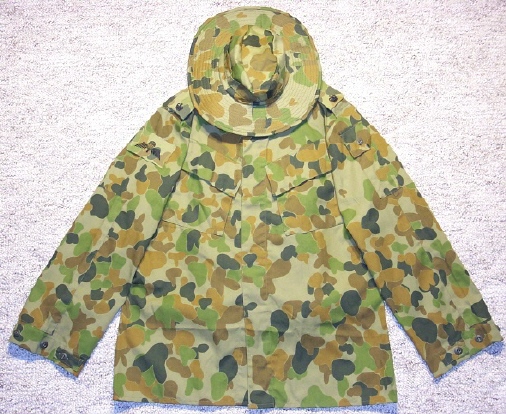
Disruptive Pattern Camouflage Uniform. DPCU is the standard working dress of the Army and RAAF in Australia.
Disruptive Pattern Desert Uniform[]
A new DPCU variant designed for desert conditions using different colours and was first tested in 1998 at the Woomera Missile Test Site in South Australia.
2001 1st Issue of DPDU. Mk1 was printed in 3 colors (Brown and Gray on a Tan Background) with 1/3 of the normal Auscam print missing, rushed into issue for Australian special forces.
2002 2nd Issue DPDU. Full Auscam print was used with a full 5 colours. The colours were: Brown, Lime Green, Gray, Very Light Blue (almost Gray) on a Tan Background.
2003 3rd Issue DPDU. This is also in the full Auscam print with 5 colours. These colours are: Brown, Grey, Very Light Blue, Purple on a Yellow Background. The cut was changed in the shirt with the bottom pockets being omitted and placed on the sleeves. This the current type issued to all ADF personnel serving overseas in arid/desert regions.

Disruptive Pattern Desert Uniform
Rank Insignia[]
Service Dress[]
Officers[]
Non-Commissioned Officers and Other Ranks[]
N.B. Private is replaced with Trooper/Gunner/Signalman/Craftsman/Musician (TPR/GNR/SIG/CFN/MUSN) in the appropriate Corps.
N.B. Field Marshal is an Australian Army rank, however no Australian Army officer has been appointed Field Marshal since Sir Thomas Blamey. The only present holder of the rank is the Duke of Edinburgh. A future appointment to the rank of Field Marshal is not anticipated while the present Queen remains on the throne.
DPCU[]
Officers[]
Non-Commissioned Officers and Other Ranks[]
DPDU[]
Officers[]
Non-Commissioned Officers and Other Ranks[]
Australian Army Cap Badges[]
In the Australian Army, cap badges are used to differentiate between the various Corps and Regiments of the Australian Army.
Regimental Cap Badges[]
Corps Cap Badges[]
 Royal Australian Army Educational Corps |
 Royal Australian Chaplains Department (Christian) |
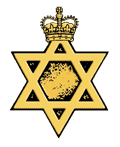 Royal Australian Chaplains Department (Jewish) |
 Australian Army Public Relations Service |

Australian Army Rising Sun badge
Historical Gallery[]




















